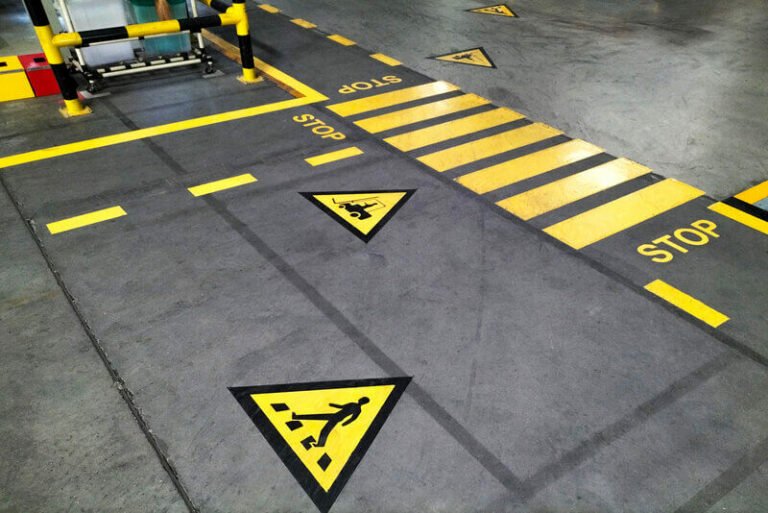Line marking is critical to urban planning, road safety, and facility management. Whether on highways, parking lots, sports fields, or industrial sites, properly applied line markings guide traffic, enhance safety, and improve organization. However, these markings are not just about painting lines on surfaces; they must adhere to specific standards and regulations to ensure consistency, visibility, and safety. This blog will delve into the essential standards and regulations governing line marking, why they are important, and how they impact different applications.
The Importance of Standards and Regulations
Standards and regulations for line marking serve several essential purposes:
- Safety: Properly marked lines help prevent accidents by providing clear guidance to drivers, pedestrians, and workers.
- Consistency: Standards ensure that line markings are consistent across different locations, making them easily recognizable and understandable.
- Durability: Regulations dictate the quality of materials and methods used, ensuring that markings are durable and maintain visibility over time.
- Compliance: Adhering to standards helps avoid legal issues and ensures that authorities and the public recognize the markings.
Key Standards and Regulations
- Road and Highway Markings
Road and highway markings are the most standardized due to their critical role in traffic safety. Here are some key aspects:
- Manual on Uniform Traffic Control Devices (MUTCD): In the United States, the MUTCD provides comprehensive guidelines for road markings, including the colour, width, and placement of lines. For instance, white lines separate lanes moving in the same direction, while yellow lines separate opposing traffic flows.
- European Norms (EN 1436): In Europe, EN 1436 outlines the standards for road marking performance, including retro-reflectivity (how well markings reflect light at night), skid resistance, and colour. Similar to the MUTCD, it ensures consistency across member countries.
- Australian Standards (AS 1742.2): In Australia, AS 1742.2 details traffic control devices for general use, including line marking. It specifies the dimensions, colours, and reflectivity required for different types of roads and conditions.
- Parking Lot Markings
Parking lots require clear and precise markings to ensure efficient use of space and safe navigation. Key standards include:
- ADA Guidelines: In the United States, the Americans with Disabilities Act (ADA) specifies requirements for accessible parking spaces, including the size of spaces and the required signage and markings.
- Local Building Codes: Many regions have local building codes that dictate the layout and markings for parking lots, ensuring safe and efficient traffic flow and adequate parking capacity.
- Sports Field Markings
Sports fields have their own set of standards to ensure fair play and safety. A reliable basketball court marking company (or for any other sports field marking) can ensure that the lines and boundaries meet official standards and stay intact through regular wear. It’s important to understand what standards and specifications are involved. These include:
- FIFA Regulations: FIFA provides detailed specifications for line markings on soccer fields, including the dimensions and placement of lines for the penalty area, goal area, and centre circle.
- National Federation of State High School Associations (NFHS): In the United States, the NFHS provides rules for marking various sports fields, including football, soccer, and lacrosse, ensuring consistency in high school sports.
- Industrial and Warehouse Markings
In industrial settings, line markings help improve safety and efficiency. Key standards include:
- OSHA Regulations: The Occupational Safety and Health Administration (OSHA) in the United States provides guidelines for floor marking in workplaces to designate walkways, hazardous areas, and equipment storage zones.
- ISO Standards: International Organization for Standardization (ISO) standards, such as ISO 7010, provide symbols and safety signs for use in industrial environments, ensuring universal understanding and compliance.
Compliance and Quality Assurance
Ensuring compliance with these standards involves several steps:
- Hiring Certified Professionals: Work with line marking contractors knowledgeable about and compliant with relevant standards and regulations.
- Regular inspections ensure that markings remain visible and in good condition. This includes checking for wear and tear and ensuring that reflective properties meet required standards.
- Using Quality Materials: Use high-quality paints and materials that meet or exceed the specified standards for durability and visibility. For instance, something like thermoplastic road marking supplies can be used as they tend to be valued for their long-lasting performance and clear visibility under various conditions.
Conclusion
Line marking standards and regulations are essential for maintaining safety, consistency, and effectiveness across various applications. Adhering to these standards ensures that line markings serve their intended purpose effectively, whether on roads, parking lots, sports fields, or industrial sites. By understanding and following these regulations, you can contribute to safer and more organized environments, benefiting both users and regulatory bodies.
